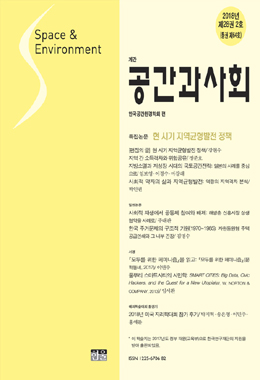이 연구는 사회적 약자의 관점에서 지역 격차와 균형 발전의 문제에 접근하고 있다. 거시적이고 ‘평균적인’ 수준에서 경제적 성과의 지역 간 격차가 완화되는 상황에서, 사회적 약자의 삶의 질, 즉 안녕(well-being)도 과연 지역 간에 균형을 이루고 있는지를 묻는다. 이 논문은 역량 접근법(Capabilities Approach)을 이용하여 지역별 사회적 약자의 안녕을 ‘역량’으로 평가하고, 이를 지역 간에 비교함으로써 이 질문에 답하고 있다. 이를 위해 우리는 ‘사회적 약자 역량 지표체계’를 구축하고 우리나라 162개 전체 시·군에 적용하여 지역 간 사회적 약자의 역량을 비교 분석한다. 분석결과는 1인당 지역내총생산이 지역 간에 균형을 이룬 것과 달리, 사회적 약자의 역량은 수도권-비수도권, 대도시-중소도시-농촌 지역 집단 간에 상당한 격차가 존재하며, 세부 지표와 차원, 그리고 영역별로도 격차가 존재함을 보여준다. 이러한 분석결과를 바탕으로 이 논문은 지역균형발전 정책이 사회적 약자의 안녕의 지역 간 격차를 해소하기 위한 사회적 포용 정책으로 확대될 필요가 있음을 주장하고, 이의 실현을 위한 정책 방향을 제시한다.
This study approaches the issues of inter-regional disparity and balanced development from the perspective of the socially underprivileged. We ask whether the quality of life, i.e. well-being of the socially underprivileged also is balanced between regions, as the regional disparities in economic performance are eased at the macro and ‘average’ level. This paper uses the Capabilities Approach to answer this question by assessing their well-being by region as ‘capabilities’ and comparing it among the regions. To this end, we have established a ‘Capabilities Indicator System for the Socially Underprivileged(CIS-SU)’ and applied it to 162 cities and counties in Korea to compare and analyze their capabilities among the regions. The analysis shows that while the GRDP per capita is balanced among the regions, the capabilities of the socially underprivileged are considerably different between the Seoul Capital Area and the Provinces, and between large cities, small and medium cities, and rural areas. Based on the results, we argue that the regional balanced regional development policy should be extended to the social inclusion policy to solve the regional disparity in terms of the well-being of the socially underprivileged and suggest policy directions for realizing this.




